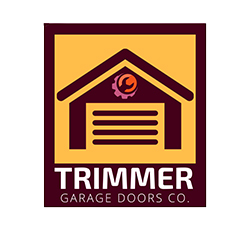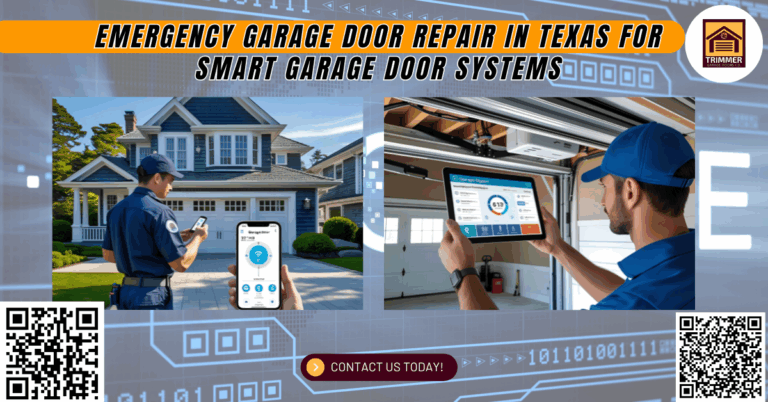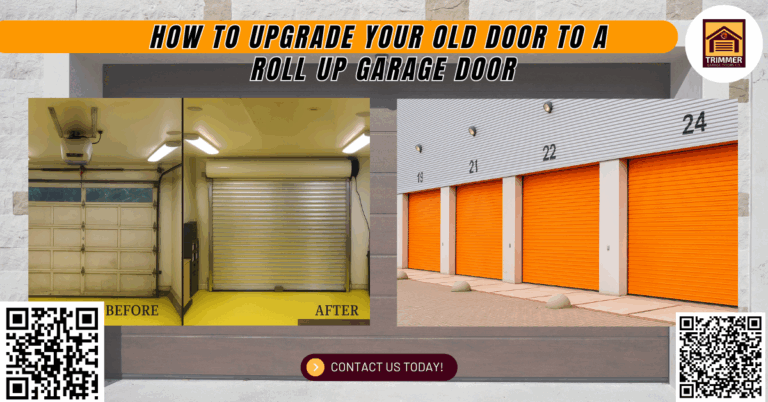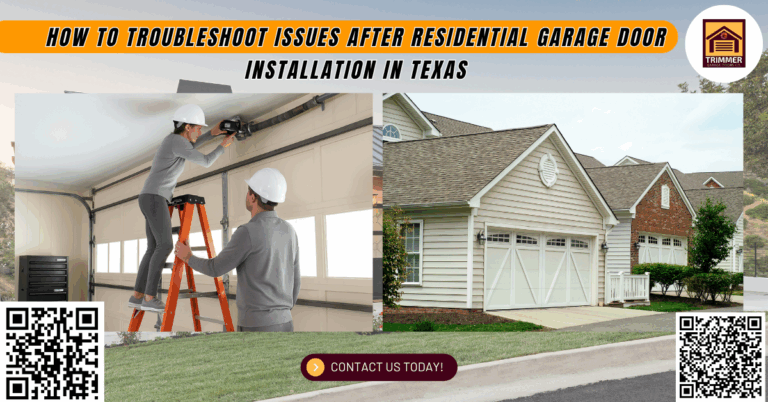Automatic garage doors are an essential part of modern households, especially in a community like Killeen, TX, where convenience, safety, and security are important for homeowners and businesses alike. These doors offer a simple push-button operation that enhances daily routines while boosting overall curb appeal. However, when your garage door system malfunctions, it can disrupt your entire day. Whether it is a power issue, mechanical failure, or weather-related problem, understanding the most common automatic garage door issues and how to resolve them is critical.
Recently, a family in Killeen experienced a common problem that could have led to a significant inconvenience. On a cold winter morning, their automatic garage door failed to close properly, leaving their garage exposed to the elements. As their garage housed essential systems like their water heater and HVAC components, the situation posed both safety and cost concerns. After a quick site visit and inspection, our team identified a misaligned safety sensor, resolved the issue, and restored full functionality in less than an hour. This real-world scenario underscores the importance of regular maintenance and prompt service.
In fact, statistics show that over 70 percent of American homeowners use their garage doors as their primary home entrance. This frequent use makes automatic garage doors not only a convenience but a critical feature in many homes. Because of their constant operation, these systems need consistent care and prompt attention when problems arise. This comprehensive guide will walk you through the common issues that affect garage door systems, providing useful tips and practical solutions.
Understanding the Anatomy of an Automatic Garage Door System
Before diving into specific problems, it is helpful to understand the key components of a typical automatic garage door system. The main elements include:
- The garage door panels are often made from steel, aluminum, wood, or composite materials.
- The opener system, which powers the lifting and lowering mechanism.
- Safety sensors, which prevent the door from closing on objects or people.
- Torsion or extension springs that counterbalance the door’s weight.
- Cables and pulleys that guide the door along the track.
- The track system allows the door to move smoothly up and down.
Familiarity with these components makes it easier to identify issues and describe problems accurately when speaking with a technician.
Power Failure and Electrical Interruption
When your garage door fails to respond, the root cause is often power-related. A non-operational garage door opener can be due to a tripped circuit breaker, a disconnected plug, or damaged wiring within the opener system. Many modern garage door systems are equipped with backup batteries, but if your system is older or lacks this feature, a simple outage could leave your door inoperable.
Start by checking the outlet where your opener is plugged in. If it is secure and the breaker has not been tripped, try plugging another device into the same outlet to test the circuit. If the outlet works but the opener still does not respond, you may have internal electrical issues requiring professional attention. At Trimmer Garage Doors Co., we ensure every installation includes properly grounded and tested power connections to minimize such disruptions.
Additional Tip: Homeowners can consider installing a battery backup system that automatically activates during power outages. This feature is especially useful in areas prone to severe weather.
Broken or Worn-Out Springs
Garage door springs, including torsion and extension types, are vital to smooth door operation. These springs bear the weight of the door and assist the motor in lifting and lowering the door safely. When a spring breaks, it often results in a loud noise, followed by a complete failure of the door to open.
Homeowners might notice that the garage door feels unusually heavy or only lifts a few inches before stopping. In these cases, the door’s balance is compromised, making it unsafe for both manual and automatic operation. Replacing springs requires specialized tools and knowledge. Attempting this repair without training can lead to severe injury. Our trained professionals offer spring replacements tailored to your garage door’s weight and dimensions, ensuring reliable performance and long-term safety.
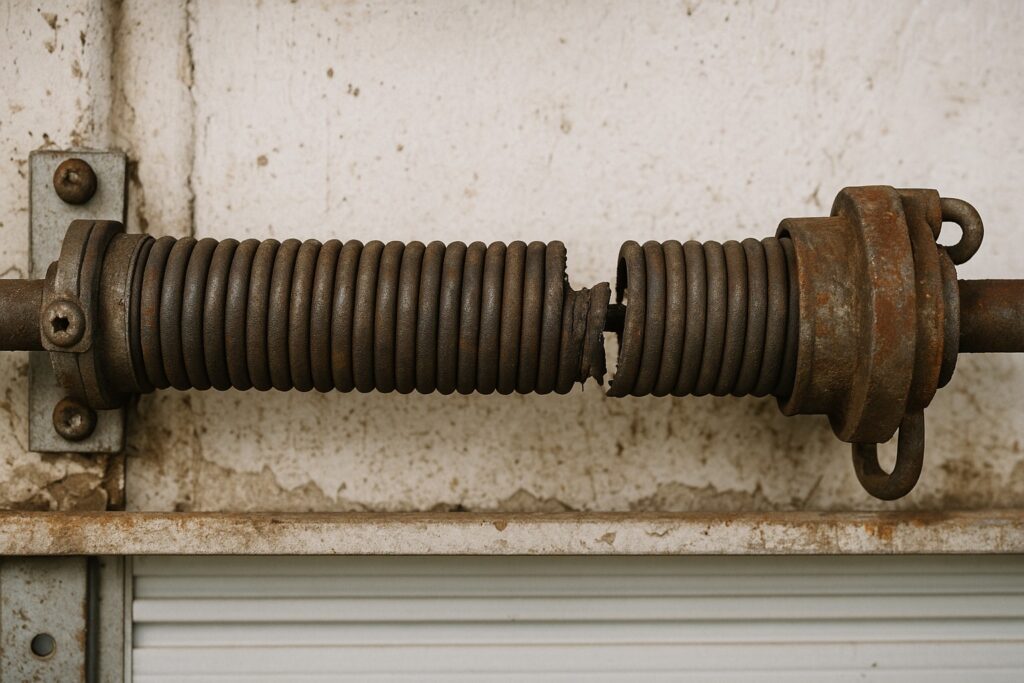
Real-Life Example: A customer in Killeen had an old wooden garage door with a broken spring. The door weighed over 200 pounds, making it impossible to lift manually. We replaced the springs with high-tension, oil-tempered models, restoring smooth operation and increasing the system’s lifespan.
Dirty or Misaligned Safety Sensors
Safety sensors are key features of all modern automatic garage doors. These small components, located near the bottom of each track, prevent the door from closing if something is in its path. If they become dirty, misaligned, or blocked by debris, the system may falsely detect an obstruction, reversing the door or preventing it from closing altogether.
To fix this, start by gently cleaning the sensor lenses with a microfiber cloth. If the problem persists, check for alignment issues. Each sensor should emit a steady light when aligned correctly. If either light is blinking or off, adjust the sensor’s position until the light remains solid. For stubborn cases or damaged units, professional garage door services are recommended to ensure the system’s safety and compliance with local standards.
Additional Tip: Make a habit of checking sensors monthly, especially in garages exposed to frequent dust, insects, or lawn debris.
Remote Control or Wall Switch Issues
Another common issue with automatic garage doors is unresponsive remote controls or wall switches. These components allow users to operate their doors from within their vehicles or homes. When either fails, it disrupts the convenience that automatic systems are known for.
Common culprits include dead batteries, disrupted signal transmissions, or internal wiring problems. Start by replacing the remote’s batteries and checking for interference from nearby wireless devices. If the issue lies with the wall-mounted switch, examine the wires for wear or corrosion. If you are unsure how to proceed, an expert can quickly diagnose and resolve the problem, restoring access to your garage door with minimal downtime.
Pro Tip: Keep a spare remote and fresh batteries in your car or emergency kit to avoid being locked out unexpectedly.
Excessive Noise or Grinding During Operation
While some noise is expected during operation, loud grinding, screeching, or rattling sounds indicate mechanical problems. These may include worn rollers, loose hardware, or dry track surfaces.
Begin by visually inspecting the track and hardware. Use a silicone-based lubricant on the rollers, hinges, and springs to reduce friction. If the noise persists, it may be time to upgrade to quieter nylon rollers or replace worn components. Keeping the garage door system in good condition through regular maintenance significantly improves its lifespan and reduces future repair costs.
Useful Insight: Nylon rollers are not only quieter but also reduce strain on the opener, extending its operational life.
Reversal of the Door Upon Closing
When a garage door starts closing but then immediately reverses, the problem often lies in the door’s close-force settings or the sensitivity of the safety sensors. If the settings are too sensitive, the system may mistake normal resistance as an obstruction.
To resolve this, consult your garage door opener manual for instructions on adjusting the close-force and limit settings. Make incremental changes and test the door’s response after each adjustment. If the door still reverses without cause, seek professional garage door services for a complete system calibration. This issue, if unresolved, can lead to energy loss, reduced security, and increased wear on the opener motor.
Practical Example: We recently adjusted the limit switch settings for a homeowner whose door kept reopening after touching the ground. After recalibrating, the door functioned normally, saving the client from unnecessary energy costs.
Frayed or Broken Cables
Cables play a vital role in balancing and guiding the garage door during operation. When these cables begin to fray or detach from their drum, the door may lift unevenly or become completely stuck.
Warning signs include a crooked door, visible cable damage, or sudden loud noises during opening or closing. Attempting to fix these cables without proper training can be dangerous. Professionals use specialized tools to release tension, replace cables, and rebalance the door. At Trimmer Garage Doors Co., we recommend regular inspections to detect cable wear early and avoid costly or hazardous failures.
Safety Reminder: Never attempt to reattach or tighten a cable without training. These components are under high tension and pose serious injury risks.
Weather-Related Damage in Killeen, TX
The weather in Killeen presents unique challenges for garage door systems. From hot summers to sudden cold fronts, these environmental changes affect materials, sensors, and mechanical systems.
Heat can cause expansion in metal components, stressing the opener system and increasing wear on rollers. Cold temperatures, on the other hand, may cause rubber seals to harden and crack, reducing energy efficiency. Dust and pollen can clog sensors and build up in track systems, leading to premature failure.
Seasonal care tips include lubricating metal parts, replacing worn weather seals, and cleaning the track and sensor areas. At Trimmer Garage Doors Co., we provide weather-specific maintenance packages designed to protect your garage doors throughout the year, regardless of Killeen’s climate shifts.
Extra Tip: Adding insulation to your garage door can help regulate temperatures inside the garage and improve energy efficiency throughout your home.
Opener Motor Malfunctions
The garage door opener is the heart of the entire system. When the motor fails, the door may hum but not move, stop midway, or operate sporadically. Opener types vary, including chain-driven, belt-driven, and screw-driven models, each with specific maintenance needs.
Common causes of motor failure include worn gears, overheating, or electrical faults. If your opener is older and frequently malfunctions, it may be time for a replacement. Modern garage door openers offer energy-efficient operation, quieter motors, and integration with smart home technologies. Our expert installers can help you choose the best opener for your garage door, ensuring compatibility, convenience, and long-term performance.
Insight: Smart openers can be controlled remotely via smartphone apps, offering added convenience and security for homeowners who travel frequently.
Garage Door Panel Damage
Panel damage is a cosmetic and structural issue that impacts the appearance and function of your garage door. Panels may dent, warp, or crack due to impact, weather, or material fatigue.
Small dents can sometimes be repaired using heat or suction tools, but larger damage typically requires panel replacement. When replacing panels, it is essential to match material, color, and insulation levels to maintain the door’s overall appearance and performance.

Expert Advice: Always assess whether replacing an entire door system is more cost-effective than replacing individual panels, especially for older systems.
Limit Switch Misconfiguration
Limit switches tell your garage door how far to move in either direction. When incorrectly set, your door may not open fully or may reverse before reaching the ground.
This problem can lead to energy inefficiency, reduced security, and frustration. Most opener systems feature dial knobs or screw adjustments for the limit switch. By carefully adjusting these, you can fine-tune the door’s movement. If unsure, contact a technician to recalibrate the settings properly.
Efficiency Tip: Properly adjusted limit switches help conserve energy and prevent excess wear on opener systems.
Track Obstructions and Debris Buildup
The track system is critical to the smooth operation of any garage door. Tracks must remain straight, clean, and free from any obstructions to ensure proper door travel. Over time, small debris like leaves, dirt, pebbles, or even dried mud can accumulate in the track, especially in homes located near construction zones or in high-dust areas like Killeen.
When a door jerks, gets stuck, or produces scraping noises, it often indicates a blocked or misaligned track. A simple visual inspection may reveal foreign objects or a slight bend in the metal. While small debris can be cleared using a brush or vacuum, bent tracks should only be repaired or replaced by trained professionals.
Helpful Tip: After stormy weather, take a moment to inspect the track area. Moisture and wind can introduce significant dirt and debris that compromise the system’s operation.
Poor Insulation and Energy Loss
A poorly insulated garage door can affect the energy efficiency of your entire home. In cities like Killeen, where temperature swings can be dramatic, inadequate insulation results in higher energy consumption as HVAC systems work harder to compensate for heat loss or gain.
Many older garage doors lack proper insulation or have worn-out weather seals that allow air drafts. Replacing seals, upgrading to insulated garage door panels, and using weather stripping around the frame can significantly improve comfort and reduce energy bills.
Real-Life Impact: A customer in Killeen who upgraded to an insulated steel garage door saw a 20 percent decrease in their summer cooling costs. The investment paid for itself within two years due to improved energy savings and better climate control.
Rust and Corrosion on Garage Door Hardware
Due to the region’s humidity and occasional rainfall, metal parts of the garage door system can develop rust. This is especially true for homes that are near gardens, sprinkler systems, or areas with poor drainage around the garage opening.
Rust affects springs, hinges, rollers, and tracks, leading to squeaking, resistance during movement, and eventual part failure. Regularly inspecting and lubricating these parts with rust-resistant products can prevent premature wear and extend the system’s operational life.
Maintenance Reminder: Check for rust every six months. If surface rust is detected, gently clean the area and apply a corrosion-resistant lubricant or protective spray.
Smart Home Integration Challenges
Modern garage door systems often come with the option to integrate with smart home technologies. These systems allow homeowners to operate and monitor their garage doors remotely using smartphone apps, voice commands, or automation routines.
However, installation and setup can be challenging for some. Compatibility issues, Wi-Fi range problems, and software bugs are common complaints. At Trimmer Garage Doors Co., we help customers select compatible smart openers and ensure they are properly configured with their existing smart home platforms.
Expert Insight: When upgrading to a smart opener, always check your Wi-Fi signal strength in the garage. A Wi-Fi extender may be necessary to maintain a reliable connection.
Impact of Garage Door Appearance on Home Value
Garage doors are one of the first things people see when they look at your home. According to national real estate reports, upgrading your garage door can yield a return on investment of up to 97 percent, making it one of the most valuable exterior improvements.
Choosing a style that complements your home’s architecture enhances curb appeal and can make a significant difference when selling your property. Popular options include carriage house designs, contemporary glass panels, and traditional raised panel styles. Adding custom hardware and selecting from premium materials like insulated steel or wood-look composites can further elevate your garage door’s visual impact.
Style Tip: Consider color coordination with your siding, shutters, and roof to create a unified and attractive exterior design.
Routine Maintenance Checklist
A structured maintenance schedule ensures your automatic garage door continues to perform reliably and safely year after year. Below is a checklist to guide homeowners:
Monthly:
- Check the photo eye sensors and wipe them clean
- Visually inspect springs, rollers, and cables
- Test the manual release handle for functionality
Quarterly:
- Lubricate all moving metal parts with a garage-specific product
- Tighten any loose nuts or bolts on the track or hinges
- Test the auto-reverse feature with a soft object in the door’s path
Annually:
- Have a professional technician perform a full inspection
- Replace the weather stripping and the bottom door seal if cracked or damaged
- Evaluate the balance and alignment of the entire door system
Pro Tip: Keep a maintenance log to track inspections, service calls, and replacements. This documentation is helpful when troubleshooting or selling your home.
Frequently Asked Questions (FAQs)
1. How long does an automatic garage door opener typically last?
Most automatic garage door openers last between 10 to 15 years, depending on usage frequency and maintenance. Regular servicing and timely part replacement can extend the opener’s lifespan significantly.
2. Can I open my automatic garage door manually during a power outage?
Yes, most garage door systems have a manual release cord, usually red, that disengages the opener from the door. Once pulled, you can lift the door manually with caution until power is restored.
3. Are automatic garage doors compatible with solar power systems?
Yes, certain garage door openers can be adapted for solar power, especially if paired with low-voltage motors and backup batteries. This eco-friendly option is ideal for energy-efficient or off-grid homes.
4. What is the average cost to replace an automatic garage door opener?
The average cost to replace a garage door opener ranges from $250 to $600, including parts and installation. The final price depends on the opener type, smart features, and local labor rates.
How to Choose the Right Garage Door System
When building a new home or replacing an aging system, selecting the right automatic garage door involves several key factors:
- Material Type: Steel offers durability and low maintenance. Wood provides warmth and aesthetic value. Aluminum is lightweight and resistant to rust.
- Insulation: Look for doors with a high R-value for better thermal performance.
- Style and Finish: Choose a design that complements your home’s architecture. Consider decorative windows or designer colors.
- Opener Type: Decide between chain, belt, or screw-driven openers based on noise tolerance and budget.
- Security Features: Opt for rolling-code technology, smart controls, and motion-sensitive lighting.
Guided Estimate: Our team provides example estimates and on-site consultations based on your current location and zip code to ensure you get a tailored solution that meets your specific needs.
Final Thoughts
Automatic garage doors are not just about convenience; they are central to home safety, daily routines, energy efficiency, and overall curb appeal. A well-maintained garage door system increases your home’s value, enhances its appearance, and provides reliable operation in all seasons.
By understanding common issues and how to identify early warning signs, homeowners can avoid unexpected breakdowns and costly emergency garage door repairs. Regular inspections, timely maintenance, and professional assistance form the foundation of a durable and high-performing garage door system.
At Trimmer Garage Doors Co., our mission is to provide expert solutions for every garage door need. Whether you are installing a new door, upgrading your opener, or troubleshooting a persistent issue, our team is here to help.
Call us today for a free estimate, inspection, or service appointment.
Trimmer Garage Doors Co.
1000 E Central Texas Expy
Killeen, TX 76541
Phone: (430) 213-4007
